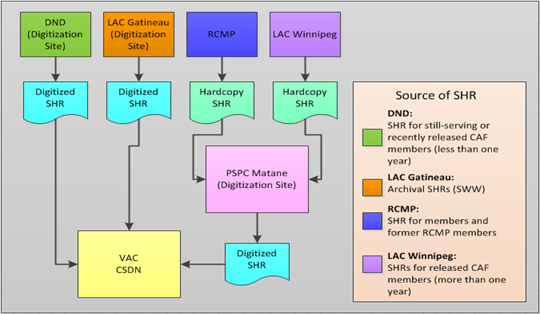Veterans Affairs Canada’s (VAC) disability pensions and awards program provides compensation to eligible still-serving or released Veterans, and members or former members of the Royal Canadian Mounted Police (RCMP).
Approval of a disability pension or award application requires the establishment of a relationship between the claimed disability or injury and service. Service and health records (SHR) that are held at the Department of National Defence (DND), the RCMP, or Library and Archives Canada (LAC) are the primary means to establish this relationship.
Prior to 2011, VAC was receiving SHRs in paper format. In an effort to reduce processing time and improve service to recipients, VAC now receives digitized versions of service and health records through partnerships with LAC, DND, RCMP and Public Services and Procurement Canada (PSPC). The digital images are uploaded to the Client Service Delivery NetworkFootnote 1 (CSDN), where they can be accessed by all authorized users who need the information. Figure 1 represents the current process of digitization of SHRs.
Figure 1: Digitization of SHRs Workflow

Figure 1: Digitization of SHRs Workflow
Source of SHR
- DND:
- SHR for still-serving or recently released CAF members (less than one year)
- LAC Gatineau:
- Archival SHRs (SWW)
- RCMP:
- SHR for members and former RCMP members
- LAC Winnipeg:
- SHRs for released CAF members (more than one year)
DND (Digitization Site)
Digitized SHR
VAC CSDN
LAC Gatineau (Digitization Site)
Digitized SHR
VAC CSDN
RCMP
Hardcopy SHR
PSPC Matane (Digitization Site)
Digitized SHR
VAC CSDN
LAC Winnipeg
Hardcopy SHR
PSPC Matane (Digitization Site)
Digitized SHR
VAC CSDN
The digitization of service and health records was implemented to improve internal processes and expedite service to VAC recipients by:
- Decreasing the time it takes to receive service and health records;
- Allowing staff to search SHRs electronically; and
- Improving access to SHRs by making them available to multiple authorized users at one time.
As of March 31, 2014, approximately 12.4 million pages were scanned since VAC began digitizing SHRs.